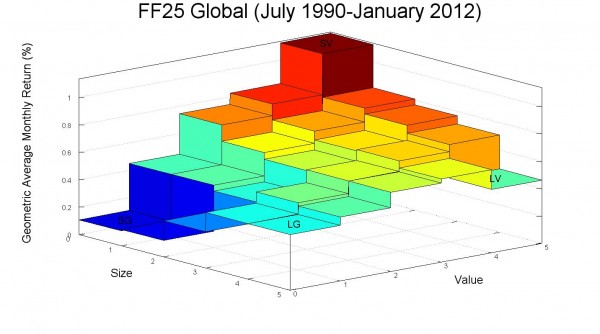International Fama-French Portfolio and Factor Data
Regular readers know that my posts frequently utilize data from the Kenneth French data library. The data library is an excellent resource for anyone interested in the small cap and value effects and the Fama-French 3 Factor model.
Recently, I learned that the data library has been expanded to include data from developed equity markets other than the U.S. This opens up a variety of interesting possibilities for further analysis!
For a start, I created some plots of the small cap and value effects for each region in the new data set. The plots use the return data for the 25 portfolios sorted by size (market cap) and value (book/market). The z-axis on each plot shows the average monthly return (geometric) for each portfolio. The returns are U.S. dollar returns.
In a previous post, I created some similar plots for the U.S. market and provided some sample Octave code for producing these plots.
The color scale for each of the plots is tied to the magnitude of the monthly return, and the mapping between color and average return is consistent across plots. This makes it easy to compare returns between the different regions. However, this color scaling does make the Japan plot a bit difficult to read since the average returns for Japan were much lower than the average returns for the other regions over the sample period.
The new data set also includes the Fama-French 3 Factor model factors (RMRF, HML, and SMB) for each region. I calculated the mean, standard deviation, Sharpe ratio, standard error, and t-stat for the factors for each region and included these results in a table below each plot.
Continue reading »
GLOBAL RMRF SMB HML
Mean 5.51% 1.71% 4.33%
Std 18.91% 9.33% 13.65%
Sharpe 0.291 0.183 0.317
StdE 4.13% 2.04% 2.98%
t-stat 1.33 0.841 1.45

